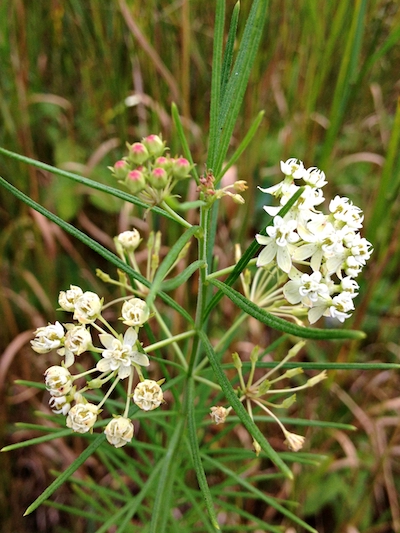Northern Natives: Whorled Milkweed
Most gardeners are aware that monarch butterflies benefit when we plant milkweed in our gardens. All species in the Asclepias genus are host plants for monarchs—they lay their eggs on the plants and the hatched caterpillars then feed on the milkweed.
Many are familiar with common milkweed (Asclepias syriaca), butterflyweed (A. tuberosa) and swamp milkweed (A. incarnata). But other milkweed species are garden-worthy, too, including whorled milkweed (Asclepias verticillata)—a beautiful plant with feathery foliage and small umbels of white, delicate flowers. Buds have touches of green and red.
In addition to being a host plant for monarch butterflies, whorled milkweed also attracts other butterflies, honeybees, bumblebees, hummingbirds and other pollinators. It blooms later in the season—generally, July through September in most of the Upper Midwest—making it a valuable nectar source and host plant when other plants have faded. While beneficial to pollinators, whorled milkweed is particularly toxic to mammals—a good thing for repelling rabbits and deer, but important to remember for placement in a garden visited by dogs, horses or other domesticated animals.

Drought-tolerant whorled milkweed will grow in regular soil, but it thrives in disturbed, dry, well-draining garden locations. In particular, it’s a good plant to use in an area of the garden where you are attempting to reduce nonnative invasive plants. It will hold the site until other plants have a chance to establish. It’s also a fun plant to grow in pots because of its spiky stature.
In the wild, it often forms drifts or colonies in fields, prairies and woodland edges. Because it blooms later, it provides garden interest from late-spring emergence through early autumn. Good companion plants include those that bloom earlier as well as low-growing, colorful plants in a pollinator garden or rock garden. Echinacea, Rudbeckia and other native, drought-tolerant plants are a few examples.
Whorled milkweed spreads by rhizomes, and under ideal conditions it will naturalize and form colonies. Clumps increase rapidly by runners, but plants can be pulled easily and transplanted. The plant is listed as rare or threatened in some areas of its range, and it’s likely to be more prevalent in parts of the state with sandy or rocky soil.
Seeds can be sown outdoors for natural germination—scatter or plant 1/8 inch deep after the first autumn frost. Water once; then allow winter snow and rain to provide moisture until spring. Seeds naturally germinate 10 to 20 days after the danger of nighttime freezing has passed. Alternatively, seeds can be sown outdoors after the last spring frost or indoors in pots after cold-moist stratification. This plant can also be propagated by division or with purchased plants.
Whorled milkweed is easy to overlook in the wild or sometimes in garden settings. Because of its grasslike foliage, it blends in with other forbs, until the buds and flowers form, with their lacy, delicate appearance. It’s hard to believe monarchs can find surface area to lay their eggs on such slender foliage, but they do. Look closely, and you’re likely to find eggs and caterpillars on this unique milkweed species.
This article by Beth Stetenfeld originally appeared in the July/August 2020 issue of Northern Gardener. She is a garden blogger and writer, and a master naturalist volunteer and instructor.

Is the plant toxic as foliage or as flowers? I’d be interested in using this in my orchard but I do have dogs who have been known to eat other grasses. Thanks, this was a terrific article!
According to Wildflower.org, all parts are toxic, though only in large quantities. Here’s the article: https://www.wildflower.org/plants/result.php?id_plant=asve